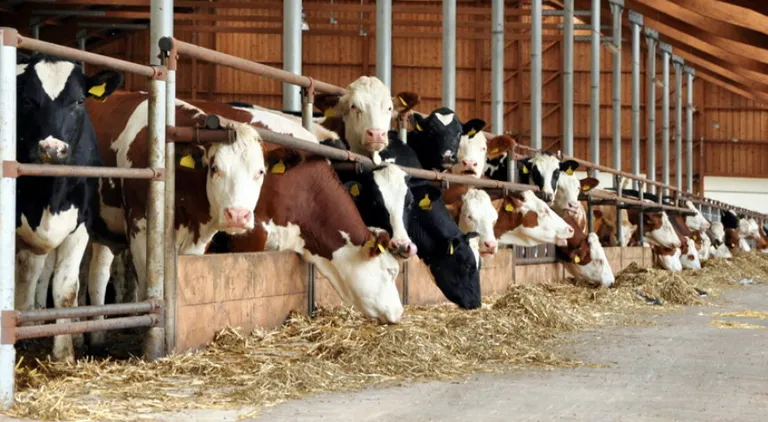
In the last blog I spoke about the Celts running their animals between two bonfires during Samhain to cleanse them and bring them good luck for the start of the New Year. Cleansing the animals at this time of year is a farming practice that is still valid today, though we’d like to think our methods of cleansing these days is more effective against parasites than a stroll through the bonfire. (But who knows, maybe it does bring luck; if prices don’t improve next year I might try for a bit of bonfire good luck next year!)
Housing is one of the best times of the year for treating cattle against some of the more common internal and external parasites, but with all the options it can be confusing as to which product to use and how best to use it. What you need to consider is that products vary in price, in what they control and in how they are given to the animal. The Key questions you need to answer when looking for a product are:
- Will type II stomach worms be controlled?
- Will lice be covered?
- Do I need to cover for liver fluke?
- How convenient is it to give the product?
- How long after housing do I need to wait before giving the treatment?
- Will I need to give a second treatment and when?
- Could rumen fluke be an issue?
- How long is the withdrawal period with any of the products used?
- What will the overall cost per animal be?
What do you need to know when selecting a product?
All of the avermectin (any product that has an active ingredient ending with ‘mectin’ eg Ivermectin), and all of the benzimidazole (mostly white drench products ending in dazole eg triclabendazole, fenbendazole) products will control type II stomach worms and lungworms.
However there has been a huge increase in resistance on many farms to both these types of products due to overuse and if you have been using one continuously for a period it is probably time for a change.
The levamisole products (mostly the clear or yellow drenches) will not kill type II stomach worms and should need to be used in conjunction with another treatment to target type II Stomach worms;
This Includes dual purpose drenches like Levafas Diamond which is a popular drench at housing for its ability to kill stomach fluke but use of another treatment to compliment it is often forgotten.
If using Levafas Diamond for this purpose you will need to use a separate wormer to catch the stomach worms.
The other products that will treat stomach Fluke is Zanil or Rumenil, both just containing Oxyclozanide, so they too will need to be used in conjunction with other products as they will not cover stomach worms.
An injection like Levacide is a popular choice.
All these products will also only treat Adult Fluke.
When it comes to a Flukicide, you will need to look at what stages the product treats, as some products will only treat adult liver fluke while others treat a range of stages. Only a small number control early immature, for example, so it is important to know which type you are using; otherwise, you may only be killing a proportion of the fluke present. For this reason many farmers will treat for fluke a couple of weeks after housing (along with their stomach worm and hoose treatment) and again later in the winter to pick up those not covered. Otherwise, you have to wait too long for fluke to mature before giving a fluke treatment that will kill all fluke in the system with just one treatment, leaving your animals open to stress from a severe infestation.
Once you’ve decided what parasites you need to treat you can start asking what way you want to administer your dose.
Drenches like Levafas Diamond, Zanil, Tramazole and Curafluke are still very popular in some places.
Others say an injection is easier to administer, covers everything with one dose and that they wouldn’t use anything else.
However this attitude is what many have attributed the growing resistance of parasites to the Avermectin products. As a result an interest has been growing for pour-ons, as they offer the same ease of use as the injections. However a lot of farmers don’t realise that many of these products are using the same active ingredients as the injections that farms have been growing a resistance too.
Ivomec, Imec and Animec all rely on Ivermectin.
In addition most pour-ons won’t treat fluke and need to be complimented with an injection or drench. Some exceptions come in the form of Closamectin and Cydectin Triclamox, which are that bit pricier as a result of their wider coverage and it should be noted that Closamectin also relies on Ivermectin so if you’ve been using Ivermectin products frequently for a few years you might need to consider Cydectin Triclamox.
When it comes to treating lice, it all depends on the amount of lice present.
Where the infestation is very severe and consistent I have been told by many farmers that the only way to go is a fistful of white rhino down the spine!
However others say it can be a little severe and instead Diatomaceous Earth powder is the best for the job. Many of the lice only treatments recommend a second treatment a number of weeks later if you have a lice infestation. If you have no lice present at housing, one treatment of Spot-on, Spotinor, Butox or Ectospec should suffice to protect the herd from infestation; so long as you have thoroughly cleaned and disinfected the shed before housing.
You will also need to be careful if introducing newly purchased animals to the herd while housed. Best practice is to treat and quarantine the animals for up to three days to insure no contamination can occur. As I said it can be very confusing figuring out which Active ingredient is in which product. That’s why here at Agridirect we’ve decided to help you out by adding the active ingredient beside the product so that you can be sure you aren’t giving your animal two products with the same, or over using one, active ingredient.
Hopefully this can help you fight back against any growing resistance on your farm, and make treating at housing that bit easier. As always if you have any queries about a product or what best to use for your situation you can contact us directly and we will be more than happy to offer our advice.
Here’s hoping we have a short winter with not too many storms.
Happy Housing.
RGA










